
Birds of Iowa
If you love nature, but don’t like to travel far for a good time, then go over to Iowa! Iowans are proud of their local wildlife, and the Iowa River Greenbelt is the perfect place for birdwatching. It’s well known that many migratory birds stop in Iowa before they head to homes farther north. Grab your binoculars and some coffee on a Saturday morning; you’ll soon find yourself in the company of one-of-a-kind avian creatures.
Other popular birdwatching spots include Saylorville Reservoir, Hawkeye WMA, and Red Rock Reservoir.
Table of Contents
Saylorville Reservoir
The Saylorville Reservoir, located in the heart of southeastern Iowa on the Des Moines, has been noted as one of America’s most impressive watersheds. Known for its scenic beauty and recreational opportunities like bird watching, it is a serene setting surrounded by forested hills. Completed in 1958, the reservoir was created to provide additional storage capacity during wetter weather to meet projected demands by US Army Corps. Now you can often spot birds like Common Merganser, Ruddy Duck, American White Pelican, and Common Goldeneye there.
Hawkeye WMA
There are many different types of habitats in the over 14,000-acre Hawkeye Wildlife Management Area, making it one of the best places in Iowa to go bird watching. Because of its breadth and diversity of habitat, the region is home to more than 290 different kinds of birds. The primary routes to know for bird-watching in the WMA are Amana Road NW and Swan Lake Road W. There you will be able to spot Greater and Lesser Yellowlegs, Ross’s Goose, Greater White-fronted Goose, Calidrises Franklin’s Gulls, American White Pelicans and various types of ducks, waterfowls, and shorebirds.
Red Rock Reservoir
Red Rock spans from a wildlife management area near Runnells, Polk County, to Army Corps of Engineers leisure grounds near Pella. The Corps manages over 40, 000 acres of federal property in the region; the IDNR leases an additional 25 000 acres for use as a wildlife management area. About 310 bird species have been seen in the area during the previous 20 years, but there should be many more if you ask any birder who goes there.
Birding in any of Lowa’s reservoirs is heavily reliant on water levels and may fluctuate on a daily basis. RRR’s storage capacity increases from its permanent size of 6,000 acres to 60,000 acres when it is at capacity. This has significant effects on both the bird population and the ease of getting to prime birding spots.
What are the Backyard Birds in Iowa?
Like my friend says you never know what you’ll find in Iowa, it is certainly the case with the backyard birds. Still, there are some more frequent visitors than others. They include American Robin, Red-bellied Woodpecker, White-breasted Nuthatch, Baltimore Oriole, Indigo Bunting, Blue Jay, Brown-headed Cowbird, House Finch, Black-capped Chickadee, American Crow, Gray Catbird, Barn Swallow, Dark-eyed Junco, Eastern Wood-Pewee, Chipping Sparrow, American Goldfinch, Northern Cardinal, Mourning Dove, Song Sparrow, Common Grackle, House Sparrow, Eastern Kingbird, House Wren, Red-winged Blackbird, Northern Flicker, Downy Woodpecker and European Starling.
Here is a list of my favorite birds that you can see in Iowa:
1. Eastern Bluebird
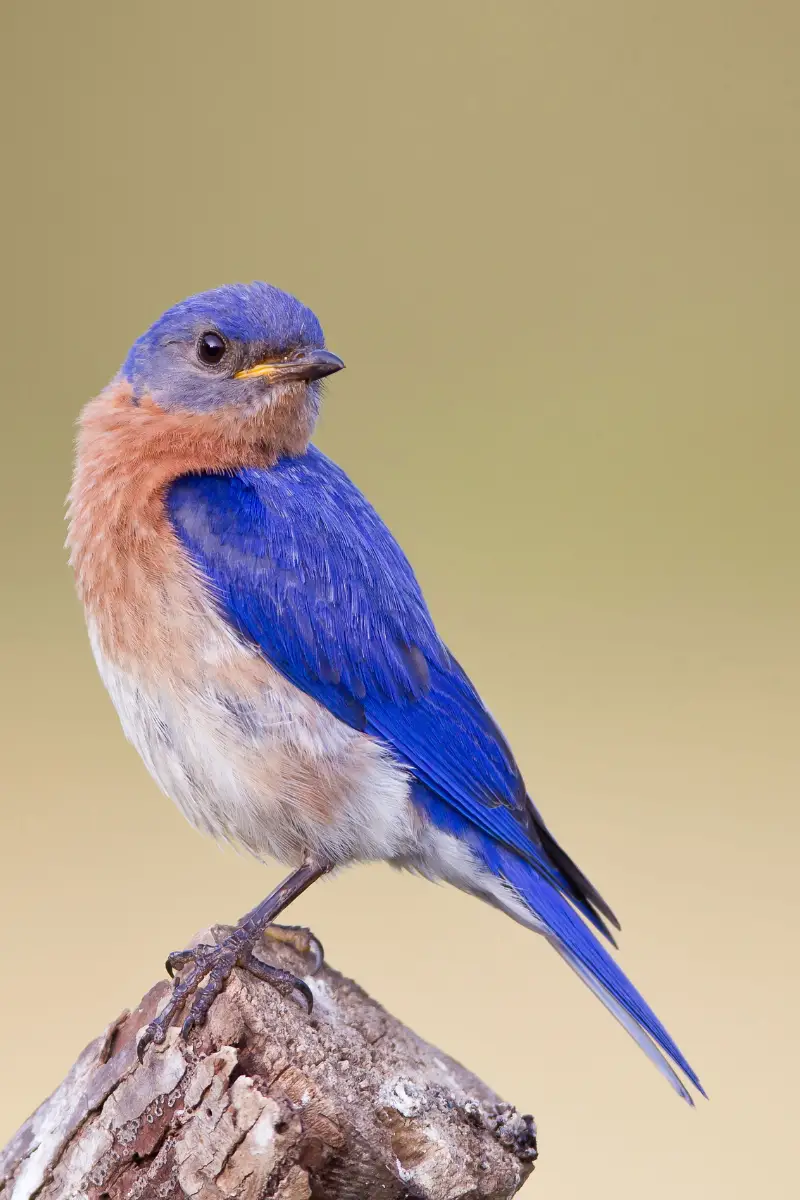
Family: Turdidae, Thrushes
Description ADULT MALE Has mainly deep blue upperparts, including scapulars; on the head the color forms a distinct cap. Throat, sides of neck, breast, and flanks are orange-red while belly and undertail are white. ADULT FEMALE Has mostly gray-brown upperparts with blue flight feathers and tail, and orange wash on underparts. JUVENILE Brown overall with pale spots on upperparts and scaly-looking underparts.
Dimensions Length: 7″ (17 cm)
Habitat Has declined markedly in recent decades, but still common overall and widespread as a summer visitor (present mainly Apr-Sep) across the north of its range; present year-round further south and winter range extends to northeastern Mexico. Favors lightly wooded terrain including regenerating woodland and large gardens. Reasons for decline include habitat destruction and degradation, but nest competition from European Starlings and House Sparrows has also contributed. Nest box schemes are helping to restore many local populations.
Observation Tips Easy to see within range; to encourage the species’ presence and reproductive success install suitable nest boxes in your garden.
Range Texas, Mid-Atlantic, Southeast, Plains, Western Canada, New England, Eastern Canada, Southwest, Florida, Rocky Mountains, Great Lakes
Voice Song is a rapid series of twittering warbling notes; call is a sharp tch’ree.
Discussion One of eastern North America’s most familiar and best-loved birds. An extremely colorful species that perches conspicuously on wires and branches, scanning for insect prey on ground below onto which it then drops. Also flycatches and gleans insects from foliage while hovering; berries are an important part of its diet in fall and winter in particular. Nests in tree holes and readily takes to nest boxes. Forms sizeable flocks outside the breeding season, sometimes mixing with other species. Sexes are dissimilar.
2. Osprey
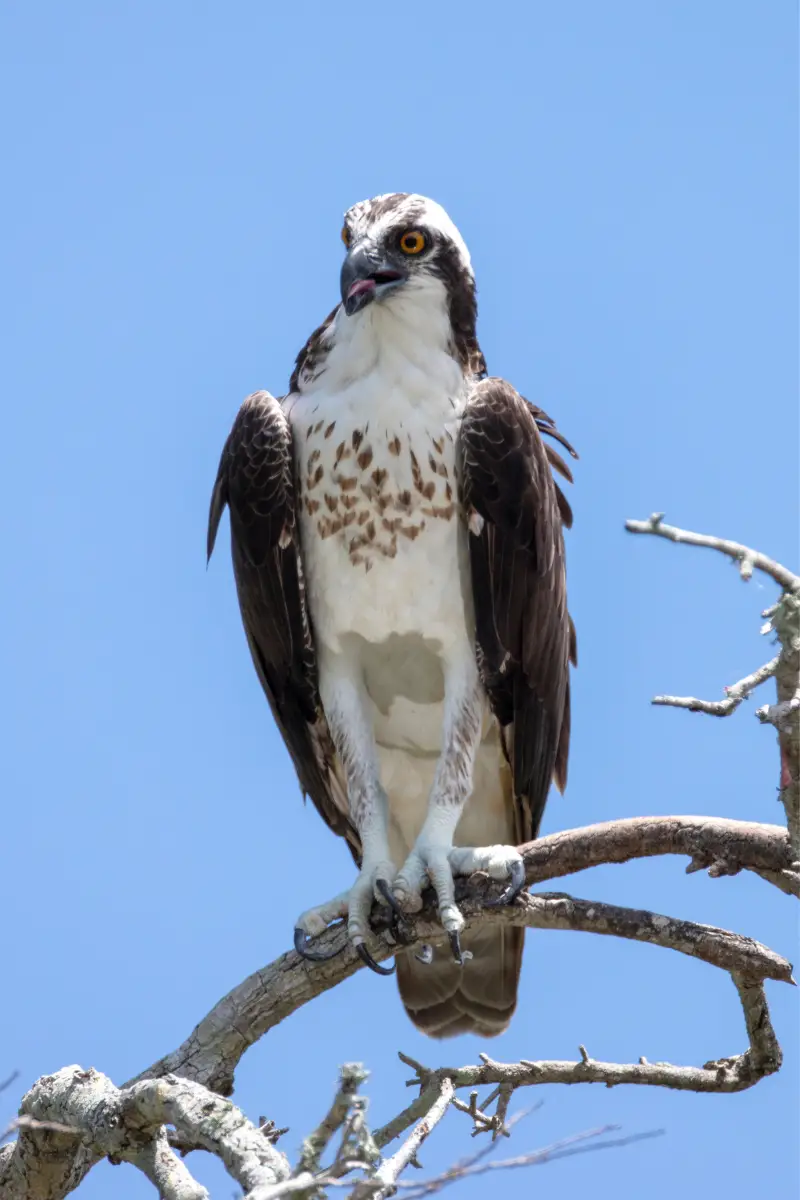
Family: Accipitridae, Hawks and Eagles
Description ADULT Has mainly brown upperparts, except for the pale crown; underparts generally look pale white; body is mostly unmarked, except for streaked chest band (most obvious in females). In flight, seen from below, inner wing coverts are pale except for dark carpal patch, while flight feathers have dark brown barring; note the dark terminal band on the barred tail. JUVENILE Similar to adult, but dark elements of plumage are paler, back and upper wing covert feathers have pale margins, and nape and chest are often flushed orange-buff.
Dimensions Length: 21-24″ (53-61 cm); Wngspn: 4′ 6 “-6′ (1.4-1.8 m)
Habitat Fairly common summer visitor to northern half of region. Associated with fish-rich lakes, rivers, and coasts. Most migrate south to Central and South America, but in southern states (notably Florida and Gulf coast) present year-round.
Observation Tips Usually easy to find on suitable wetland habitats within range. Spends long periods perched, often on a dead tree, and so careful scrutiny of waterside trees may be required. In some areas, they are bold enough to build their twiggy nests on manmade structures such as powerline poles and towers.
Range Southeast, Plains, Southwest, Alaska, Rocky Mountains, California, Texas, Great Lakes, Mid-Atlantic, Florida, Eastern Canada, Western Canada, New England, Northwest
Voice Utters various whistling calls.
Discussion The classic fish-eating raptor, invariably seen near water. In soaring flight, with its rather long, narrow wings, it can look rather gull-like. However, fishing technique is unmistakable: typically hovers and then plunges, talons first, into water.
3. Olive-sided Flycatcher
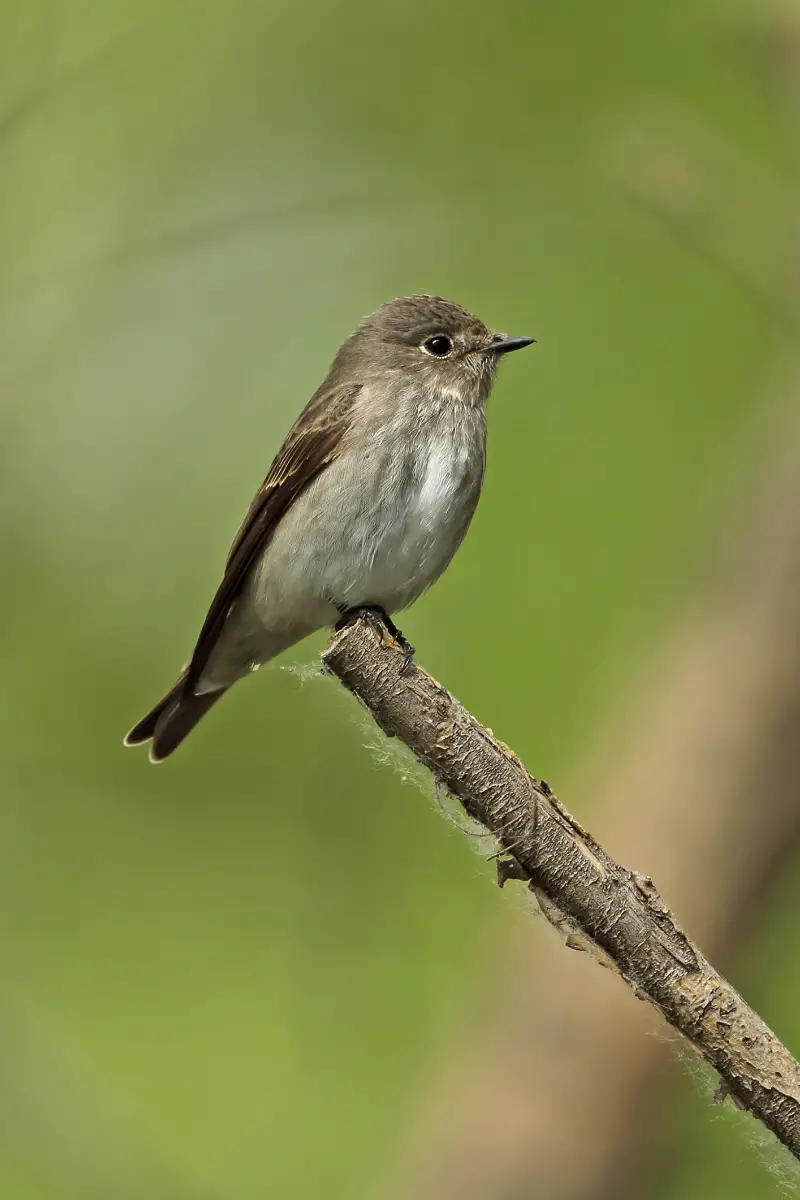
Family: Tyrannidae, Tyrant Flycatchers
Description ADULT Has mostly dark olive-brown upperparts, with indistinct pale eyering. Wings and tail are mostly blackish with faint pale wing bars; white feathers on side of rump sometimes overlap inner wing feathers at rest. Throat is white and color continues down center of breast to belly and undertail. Streaked dark olive-brown flanks look like an unbuttoned vest. JUVENILE Similar, but plumage, including wing bars, is warmer buff overall.
Dimensions Length: 7 1/2″ (19 cm)
Habitat Widespread and still locally common summer visitor (mainly May-Aug) to boreal forests and damp, coniferous woodland. Has declined markedly in recent years. Forest loss and degradation here, and in South American winter quarters, are probably to blame.
Observation Tips Easy to observe, but scarcer in recent years.
Range Alaska, Mid-Atlantic, Southeast, Plains, Western Canada, New England, Northwest, Eastern Canada, California, Southwest, Florida, Rocky Mountains, Great Lakes, Texas
Voice Utters a liquid quip-wee-ber or a rapid wip-wip-wip.
Discussion Plump-bodied, rather dark-looking flycatcher. Often perches on exposed dead branches, adopting an upright posture. Flying insects caught in aerial forays. Bill is dark and relatively large, and tail is short. Sexes are similar.
4. Northern Waterthrush
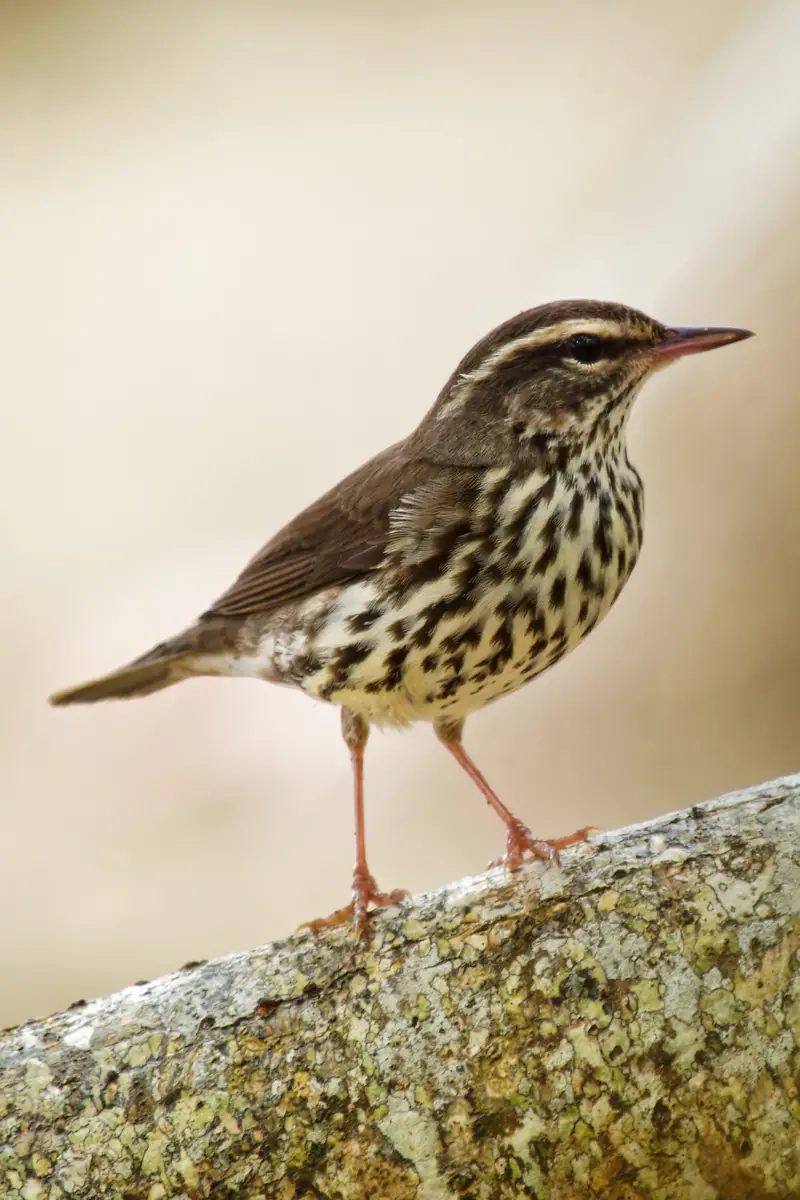
Family: Parulidae, Wood Warblers
Description ADULT AND IMMATURE Have mostly dark olive-brown upperparts, including wings and tail. Note the long, bold supercilium that is an even width and buffy along its entire length. Underparts are whitish overall, with a yellow wash (variable in intensity); has bold dark streaks on throat and all areas of underparts, except undertail coverts. Legs are stout and dull pink.
Dimensions Length: 6″ (15 cm)
Habitat Common summer visitor (mainly May-Aug) to wet habitats (bogs, streams, and rivers) in wooded regions. Winters in Central and northern South America.
Observation Tips Unobtrusive but fairly easy to see. Found in waterside habitats, even on migration.
Range Alaska, Northwest, Texas, Eastern Canada, Western Canada, Southeast, Great Lakes, New England, Mid-Atlantic, Florida, Plains, California, Rocky Mountains, Southwest
Voice Song is a rich tu’et-tu’et-tu’et-tu’et tchu-tchu-tchu-tchu; call is a thin, sharp tzip.
Discussion Well-marked, rather atypical warbler. Often found near water, typically foraging along muddy margins, constantly pumping tail up and down. Similar to Louisiana, but see that species’ description for separation details. Sexes are similar.
5. Philadelphia Vireo
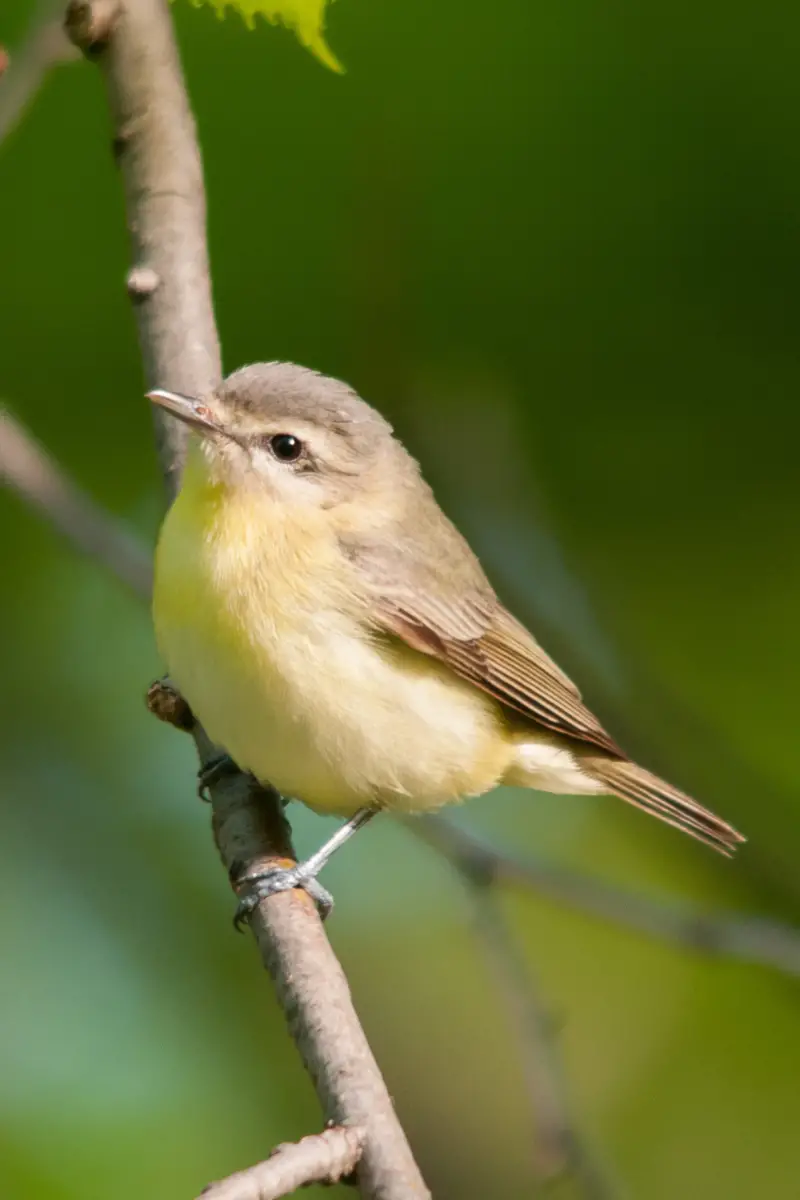
Family: Vireonidae, Vireos
Description ADULT Has an olive-green back and neck with a grayish crown, white supercilium, and dark eyestripe with a white line below. Underparts, including throat, variably flushed yellow with least amount of color on belly. JUVENILE Similar, but yellow on underparts is more obvious.
Dimensions Length: 6″ (15 cm)
Habitat Generally rather scarce summer visitor (mainly May-Sep) to new growth deciduous woodland; often in similar habitats to Red-eyed Vireo although the two species’ behavior ensures there is little overlap when feeding and nesting.
Observation Tips Easiest to detect by song.
Range Texas, New England, Southeast, Florida, Southwest, Plains, Western Canada, Eastern Canada, California, Rocky Mountains, Great Lakes, Mid-Atlantic
Voice Song comprises a series of short phrases with pauses in between, rather similar to that of Red-eyed Vireo; call is a nasal tchrrr.
Discussion Short-billed, short-tailed, warblerlike vireo. Specifically, appearance overall recalls Tennessee Warbler, from which it is told by its stouter bill, relatively larger head, and stronger plumage patterns. Forages for insects in a more deliberate manner than most warblers. Sexes are similar.
6. Blackpoll Warbler
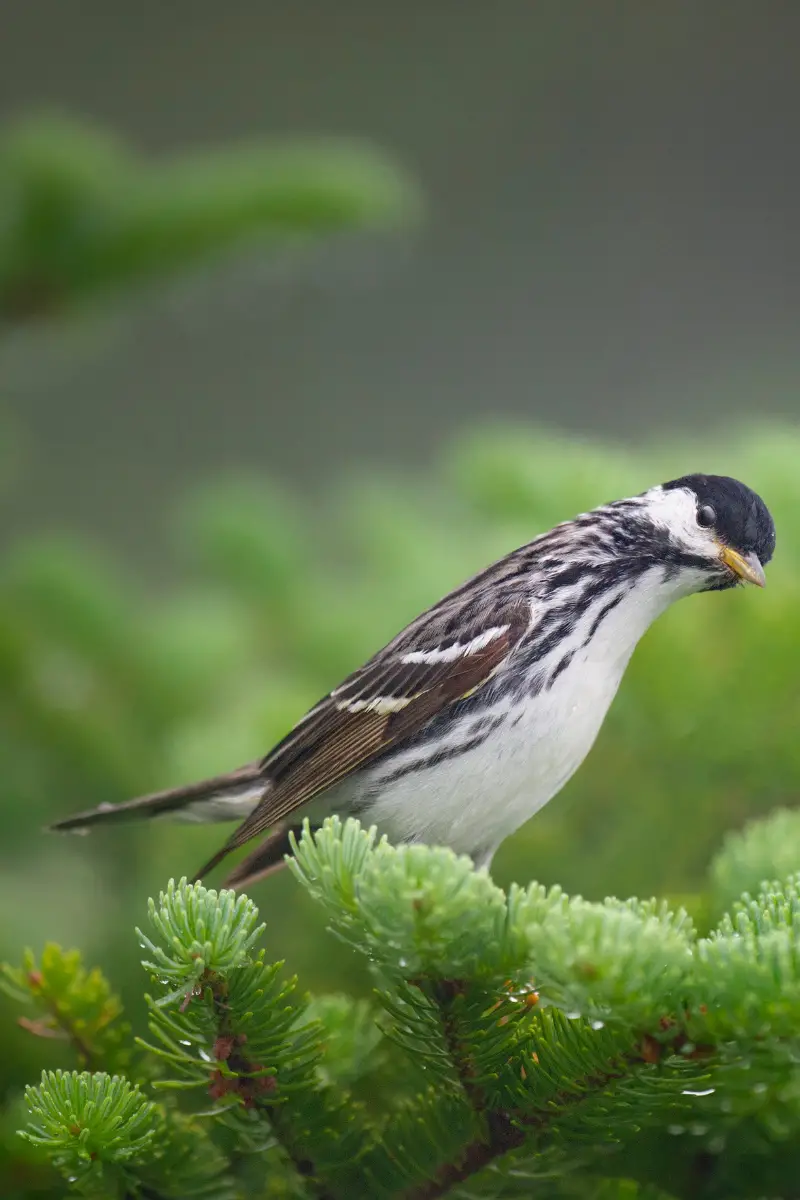
Family: Parulidae, Wood Warblers
Description SPRING MALE Has olive-gray, dark-streaked back and nape, with black cap and white cheek, defined below by black malar stripe. Underparts are white, with bold black streaks on flanks. Legs and feet are orange-yellow. SPRING FEMALE Recalls male, but head is mostly streaked olive-gray, except for whitish throat and dark malar stripe. FALL ADULT Similar to spring female. IMMATURE Recalls fall adult, but has olive-yellow wash to upperparts and brighter yellow face and underparts. Compared to immature Bay-breasted, note orange legs and feet and white (not buff) undertail coverts.
Dimensions Length: 5 1/2″ (14 cm)
Habitat Common summer visitor (Jun-Aug) to boreal, particularly spruce, forests; winters in northern South America.
Observation Tips Easy to see.
Range Southwest, Alaska, Great Lakes, Rocky Mountains, Florida, Texas, Mid-Atlantic, Plains, Eastern Canada, Northwest, Southeast, New England, Western Canada, California
Voice Song is a short series of high-pitched, thin notes; call is a sharp chip.
Discussion Striking wood-warbler in spring (especially male), more tricky to identify in fall: immature is similar to other warbler species, notably Bay-breasted. Sexes are dissimilar.
7. Cliff Swallow
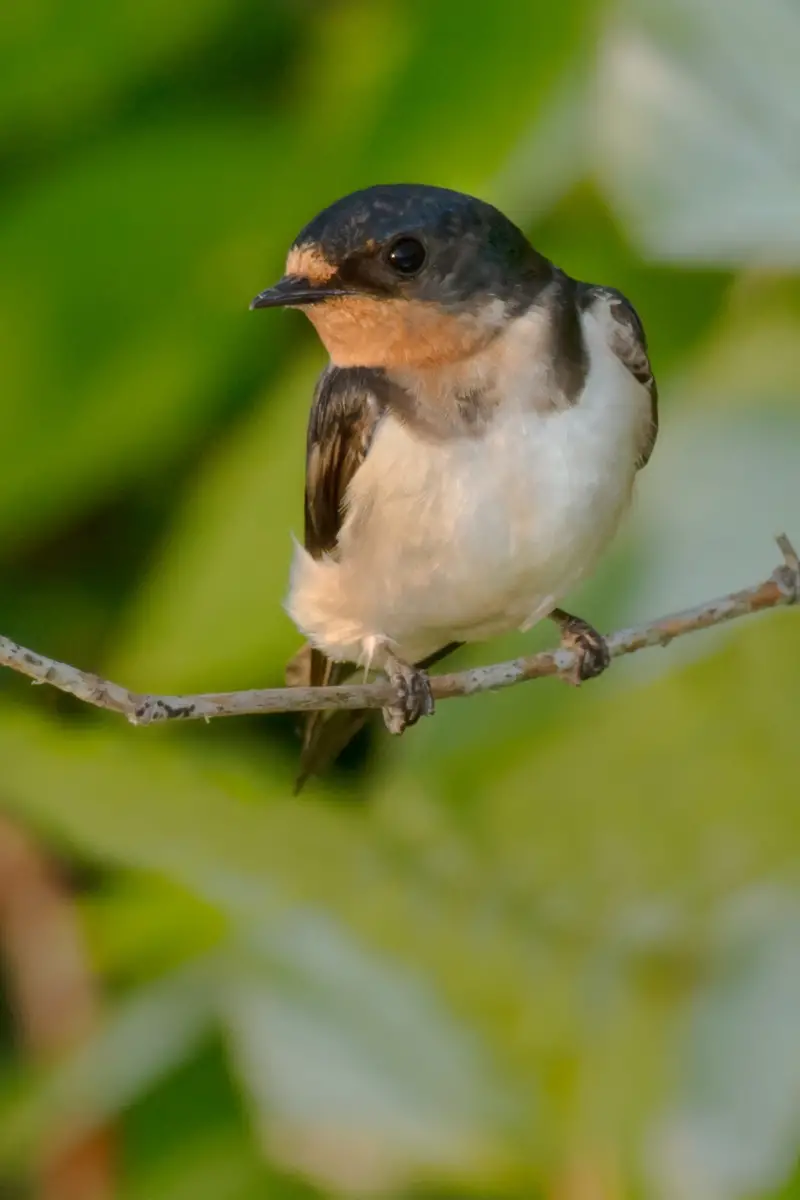
Family: Hirundinidae, Swallows
Description ADULT Has bluish black cap and white-lined bluish black back. Note the pale collar, reddish orange cheeks, and dark throat; forehead is white in most birds. Rump is buffy and square-ended tail is dark. Underparts are mostly pale with darker spots on undertail coverts. JUVENILE Duller than adult, with unmarked back; lacks reddish elements of facial plumage and has paler rump. Throat is dark (cf. juvenile Cave).
Dimensions Length: 5-6″ (13-15 cm)
Habitat Common summer visitor (mainly Apr-Sep) to a wide range of habitats. Winters in South America.
Observation Tips Easy to find.
Range Texas, Rocky Mountains, Southwest, Southeast, Alaska, California, Eastern Canada, Mid-Atlantic, Florida, Great Lakes, Northwest, Western Canada, Plains, New England
Voice Utters various soft twittering notes.
Discussion Compact swallow with broad-based, triangular, and relatively short wings. Pale orange-buff rump, obvious in flight, is diagnostic across much of range, but beware of confusion with Cave Swallow within that species’ limited North American range. Nests colonially, making mud nests on cliffs and manmade structures. Catches flying insects on the wing. Sexes are similar.
8. Brown-headed Cowbird
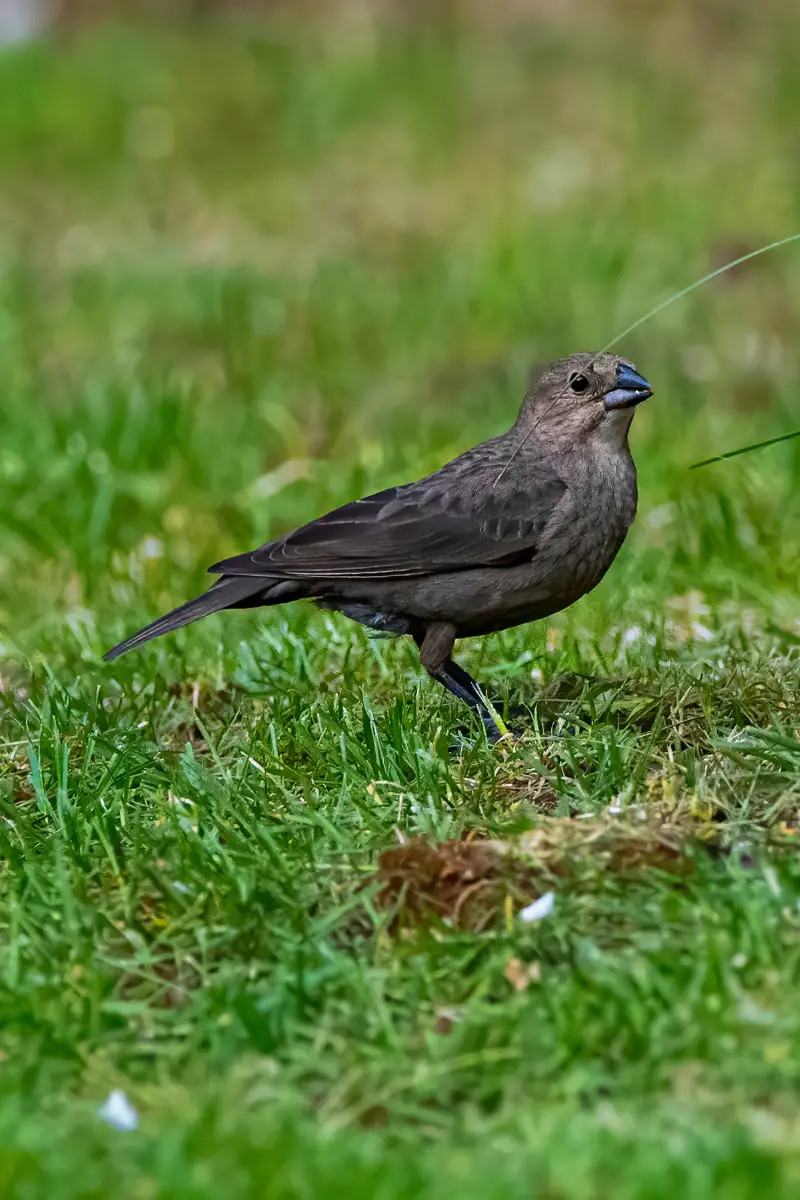
Family: Icteridae, Blackbirds and Orioles
Description ADULT MALE Has a dark brown hood and otherwise blackish plumage, with a green sheen in good light. ADULT FEMALE Plain brown overall, darkest on wings and tail; note the subtly pale throat, malar stripe, and eye surround and supercilium. JUVENILE Similar to adult female, but with pale feather margins on back, faint pale wing bars, and streaked underparts.
Dimensions Length: 6-8″ (15-20 cm)
Habitat Common and widespread in farmland and open habitats. Resident in south of range but a migrant summer visitor (present mainly Apr-Aug) to northern and interior regions. Range and population expanded greatly during 19th century: Benefited from forest clearance and creation of farmland.
Observation Tips Hard to miss.
Range Florida, Texas, Mid-Atlantic, Plains, Eastern Canada, Northwest, Southeast, New England, Western Canada, California, Southwest, Alaska, Great Lakes, Rocky Mountains
Voice Song is a couple of quacking gurgles followed by a thin, upslurred whistle; call is a rattling krrr’k.
Discussion Widespread and familiar open country bird, reviled in some quarters because of the impact its nest-parasitizing lifestyle has on songbirds. Effect on certain endangered species is undeniable but, as with most things in natural world, the story behind many species’ decline is seldom clear-cut. Sexes are dissimilar.
9. Black-capped Chickadee
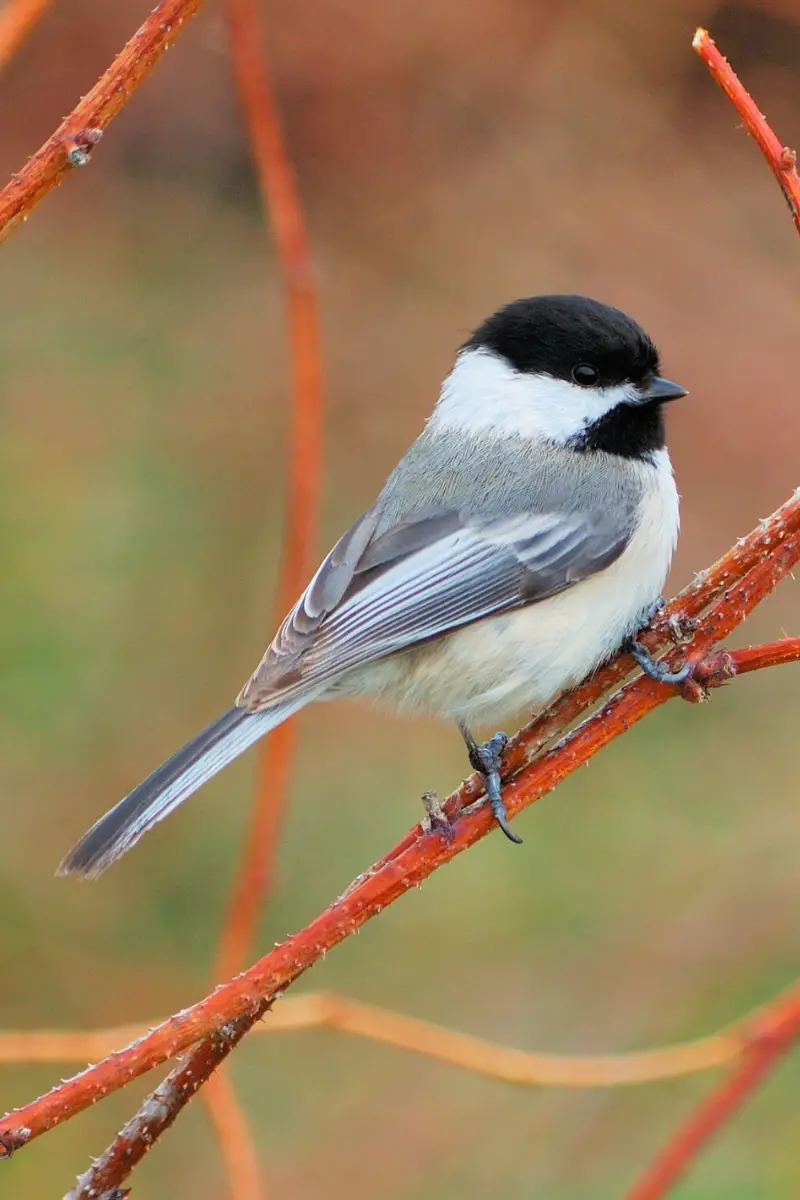
Family: Paridae, Chickadees and Titmice
Description ADULT Has a gray-buff back and mostly dark wings, but with whitish edges to inner flight feathers and greater coverts, forming a pale panel. Head has prominent black cap, extending narrowly down nape, and neatly defined black throat and bib. White on face covers cheeks and extends to sides of nape. Underparts are otherwise pale with buffy pinkish wash to rear of flanks. Tail is dark with pale fringes to feathers. Legs are gray and short, stubby bill is dark. JUVENILE Similar to adult.
Dimensions Length: 4 3/4-5 3/4″ (12-15 cm)
Habitat Widespread and common resident in a wide range of wooded habitats, including gardens and urban parks.
Observation Tips Usually extremely easy to see.
Range Western Canada, Northwest, Eastern Canada, Great Lakes, Southwest, Plains, Rocky Mountains, Alaska, New England, Mid-Atlantic, California, Southeast
Voice Song is a whistled, disyllabic fee-bee; calls its name: chika-dee-dee-dee.
Discussion Regular visitor to bird feeders and typically indifferent to people, especially ones who provide food. Nests in tree holes, but readily occupies nest boxes. Feeds on invertebrates and seeds, according to season, and joins roving mixed species flocks outside breeding season. Sexes are similar.
10. Northern Parula
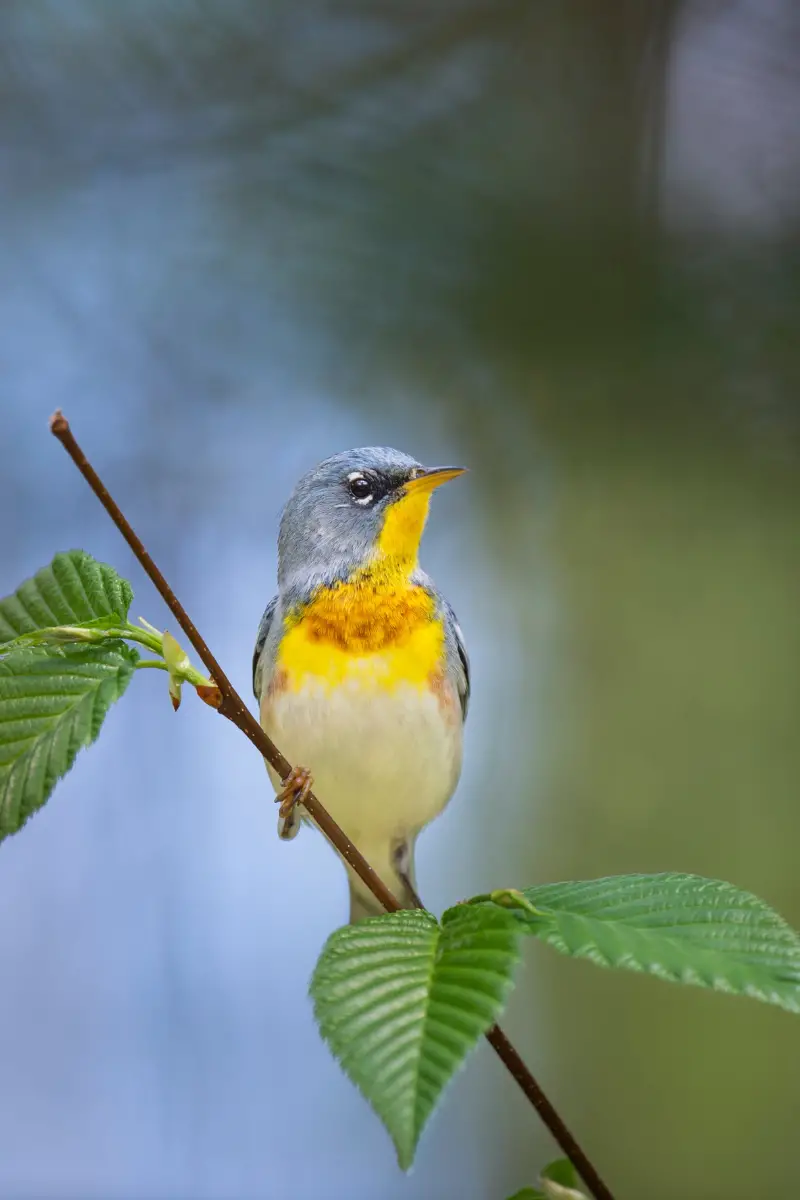
Family: Parulidae, Wood Warblers
Description ADULT MALE Has mainly blue upperparts with greenish patch on back; note the bold white wing bars and white “eyelids.” Underparts are mostly yellow, with blue and orange breast band, and grading to white on undertail. Lower mandible is yellow and legs are dull orange. ADULT FEMALE Similar to male but less colorful and without breast band. IMMATURE Similar to female, but less colorful.
Dimensions Length: 4 1/2″ (11 cm)
Habitat Common summer visitor (mainly Apr-Aug) to deciduous, coniferous, and mixed forests; favors woodlands of sufficient maturity to have a good growth of epiphytic plants. Winters in Central America.
Observation Tips Easy to see. Singing birds provide the best opportunities for prolonged observation.
Range California, Texas, Eastern Canada, Rocky Mountains, Southwest, Southeast, Great Lakes, New England, Mid-Atlantic, Western Canada, Florida, Plains
Voice Song is a buzzing, squeaky trill; call is a sharp tzip.
Discussion Colorful and distinctive wood-warbler. An active species that often forages high in treetops; this can make getting prolonged views a challenge. Sexes are separable.
11. Ovenbird
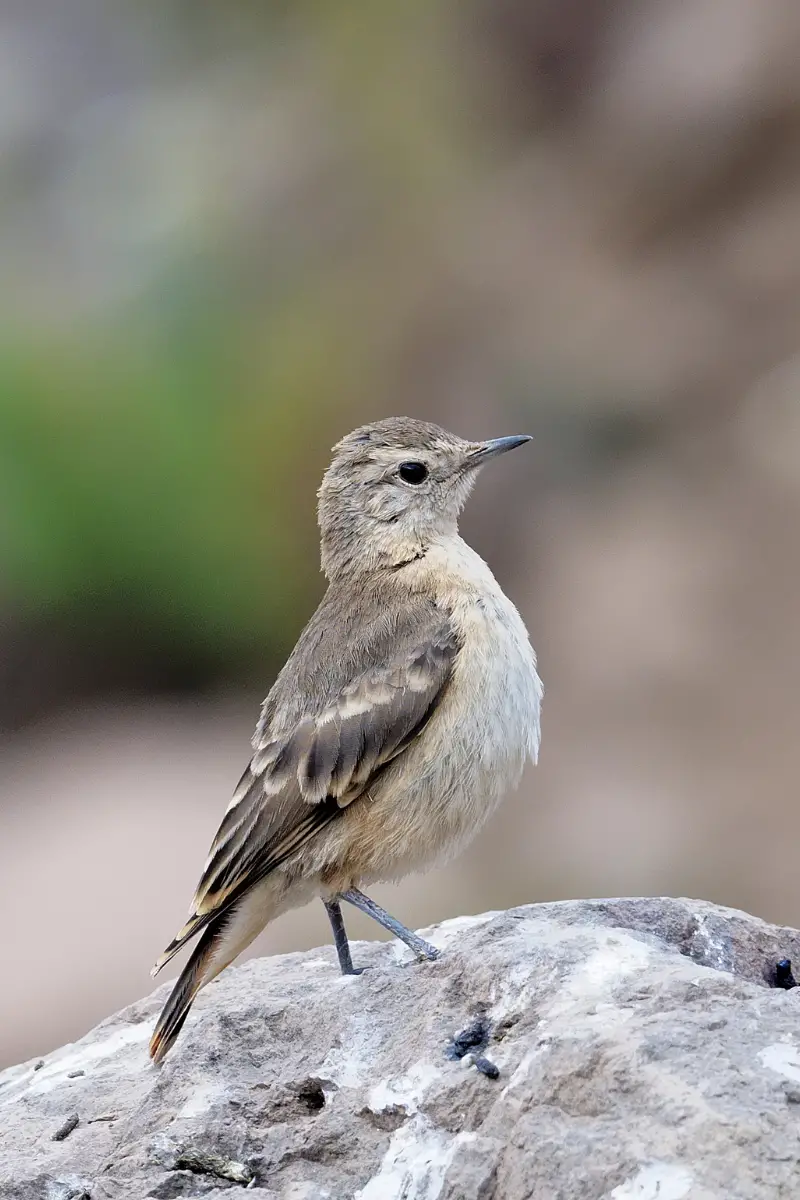
Family: Parulidae, Wood Warblers
Description ADULT Has mostly olive-brown upperparts and wings. Has a striking black-bordered, orange crown. Face is olive-brown, with white eyering surrounding the dark eye. Throat is white with black malar stripe; underparts are otherwise mostly white with bold black spots and streaks, concentrated mainly on the breast and flanks. Legs are pinkish. IMMATURE Similar to adult, but has two subtly pale wing bars; crown color is marginally less intense.
Dimensions Length: 6″ (15 cm)
Habitat Common summer visitor (mainly May-Aug) to mature deciduous and mixed forests; least numerous in west of range. Winters mainly in Central America but to limited extent also in southern U.S.
Observation Tips Listen for the distinctive song, and look for birds foraging unobtrusively on forest floor.
Range Southeast, Great Lakes, New England, Mid-Atlantic, Florida, Plains, California, Rocky Mountains, Southwest, Alaska, Texas, Eastern Canada, Western Canada
Voice Song is a vibrant, whistling ke’Chee ke’Chee ke’Chee ke’Chee; call is a sharp tsik.
Discussion Plump, mainly terrestrial wood-warbler. Appearance and some of its habits recall those of thrushes. Forages among leaf litter on forest floor for invertebrates. Combination of crown pattern and proportionately large eye (emphasized by striking white eyering) are diagnostic. Species is named after its domed nest that is sited on the ground. Sexes are similar.
12. Downy Woodpecker
Family: Picidae, Woodpeckers
Description ADULT MALE Has mainly black upperparts, but with white spots and barring on wings, white stripe on back, and barred white outer tail feathers. Head has black cap, ear coverts, mustache, and lower nape, with red patch on upper nape. Underparts and rest of head are otherwise white. ADULT FEMALE Similar, but nape is entirely black. JUVENILE Similar to adult female but with dull red patch on crown.
Dimensions Length: 6″ (15 cm)
Habitat Common and widespread resident of deciduous woodland, parks, and gardens, and to lesser extent of coniferous forest.
Observation Tips Unobtrusive and rather easy to overlook. Often visits feeders, when it is easy to observe.
Range Rocky Mountains, Southwest, Northwest, Western Canada, New England, California, Great Lakes, Mid-Atlantic, Texas, Plains, Eastern Canada, Florida, Southeast, Alaska
Voice Utters an agitated, chattering ki-ki-ki-ki and a sharp pic. Drumming is rapid, but slower than that of Hairy.
Discussion North America’s smallest woodpecker. Often feeds on slender branches, males more so than females. Excavates tree holes for nesting. Sexes are separable.
13. Common Yellowthroat
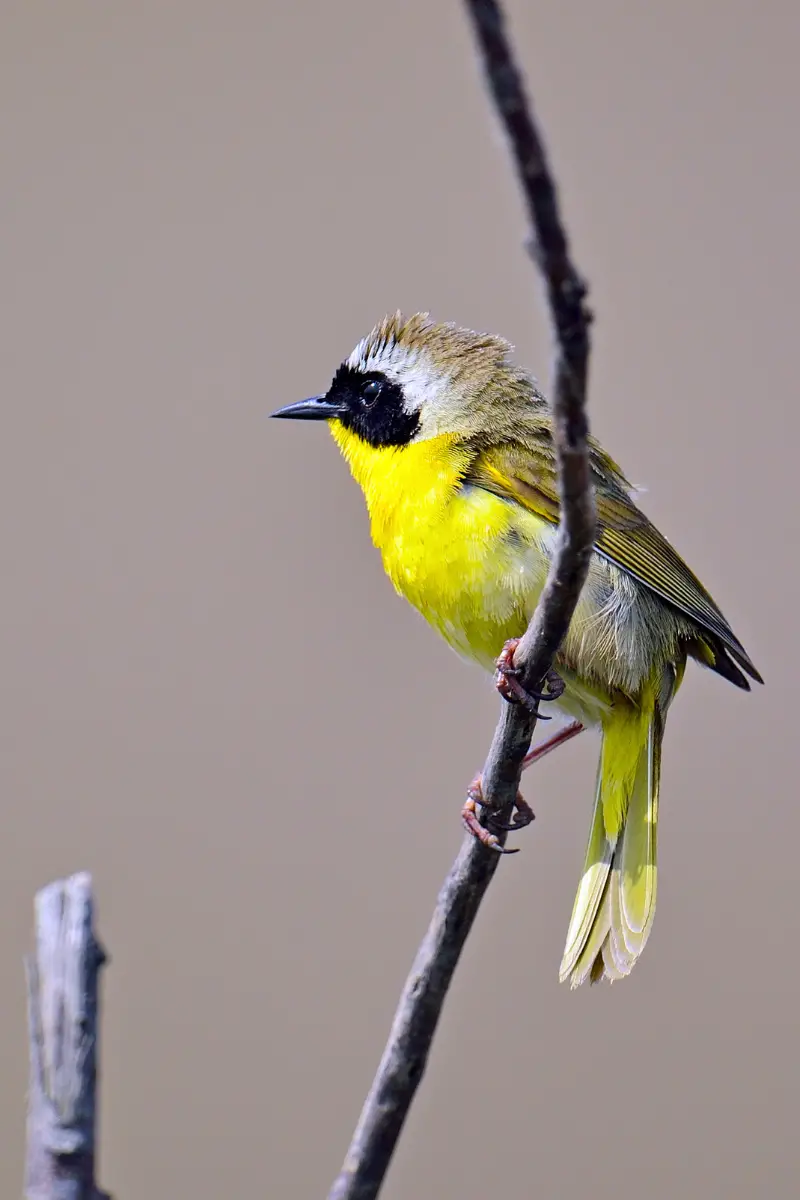
Family: Parulidae, Wood Warblers
Description ADULT MALE Has olive-brown nape, back, wings, and tail. Head has broad, black mask, bordered above by a broad, grayish band, and below by bright yellow throat. Most eastern birds have bright yellow undertail coverts and grayish flanks; flanks of Gulf coast birds are usually buffish brown; western birds (outside range covered by this book) have uniformly bright yellow underparts. Legs are pink in all birds. ADULT FEMALE Lacks male’s striking head markings (face is olive-brown), but is otherwise similar, given regional variation; yellow throat and undertail coverts are striking in all birds. IMMATURE Similar to adult female, but throat is less colorful.
Dimensions Length: 4 1/2-6″ (11-15 cm)
Habitat Common summer visitor (mainly Apr-Aug) to grassy and brushy marsh habitats, often near water. Winters from southern U.S. through Central America.
Observation Tips Learn the song and call.
Range Eastern Canada, New England, Northwest, Rocky Mountains, Texas, Southwest, Plains, Great Lakes, Western Canada, California, Alaska, Florida, Mid-Atlantic, Southeast
Voice Song is a vibrant, whistled wee-ter, wee-chertee, wee-chertee, wee; call is a tongue-smacking tchet.
Discussion Secretive wood-warbler, easier to hear than to see. Black mask makes male unmistakable. Sexes are dissimilar.
14. Cooper’s Hawk
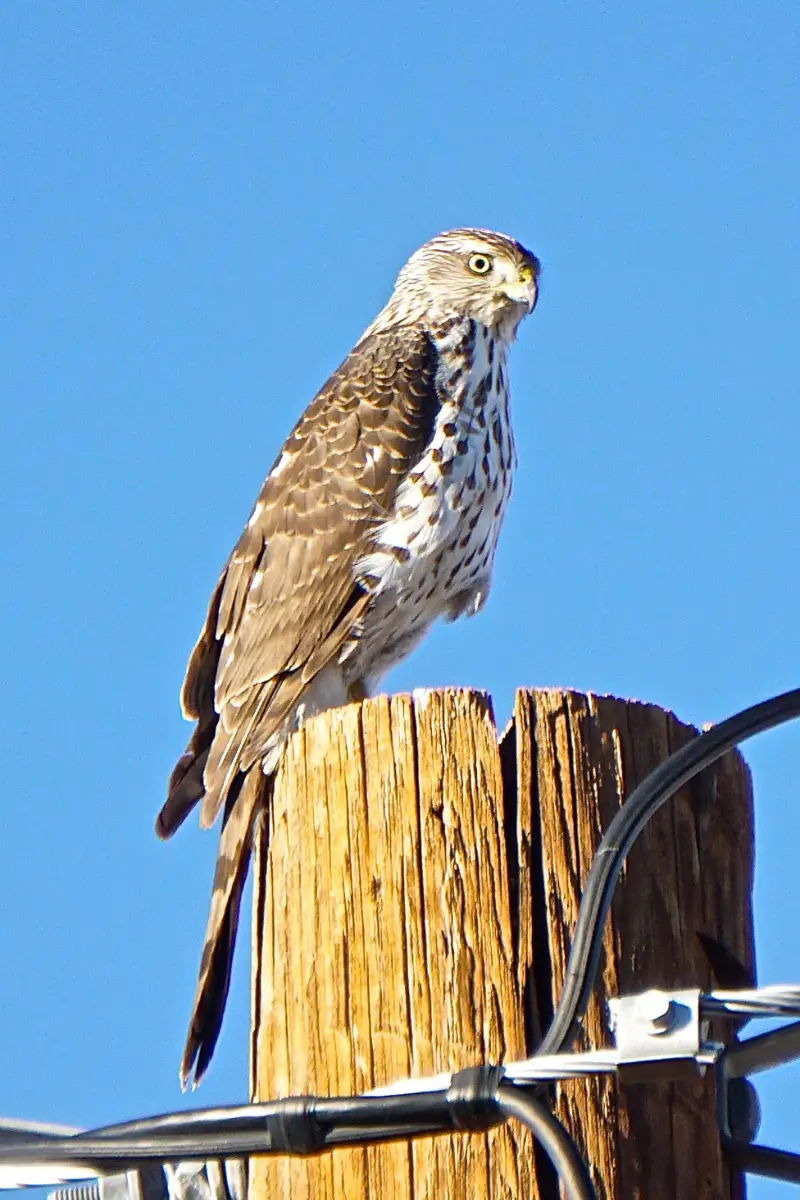
Family: Accipitridae, Hawks and Eagles
Description ADULT Has dark blue-gray upperparts, darkest on crown and palest on nape (creating capped effect). Underparts are paler and barred orange-rufous. JUVENILE Has brown upperparts and pale underparts with bold dark brown streaks.
Dimensions Length: 14-20″ (36-51 cm); Wngspn: 28″ (71 cm)
Habitat Widespread and common in wooded country. Northern populations move south in fall.
Observation Tips Seen mainly by chance.
Range Southeast, Rocky Mountains, Plains, Texas, Eastern Canada, Western Canada, California, Great Lakes, Northwest, New England, Florida, Mid-Atlantic, Southwest
Voice Utters kiek-kiek-kiek call at nest; otherwise silent.
Discussion Medium-sized accipiter. Catches larger prey than does Sharp-shinned. Compared to that species, note relatively longer wings, longer and rounded (not square-ended) tail, and appreciable neck. Plumage differences are little use in flying birds, but note Cooper’s more fluid wing action in active flight, and wings held out straighter (not angled forward) when soaring. Seen perched, gentle slope of forehead is more continuous with line of thick bill (steeper forehead in Sharp-shinned). Sexes are similar; female is larger than male.
15. Yellow-billed Cuckoo
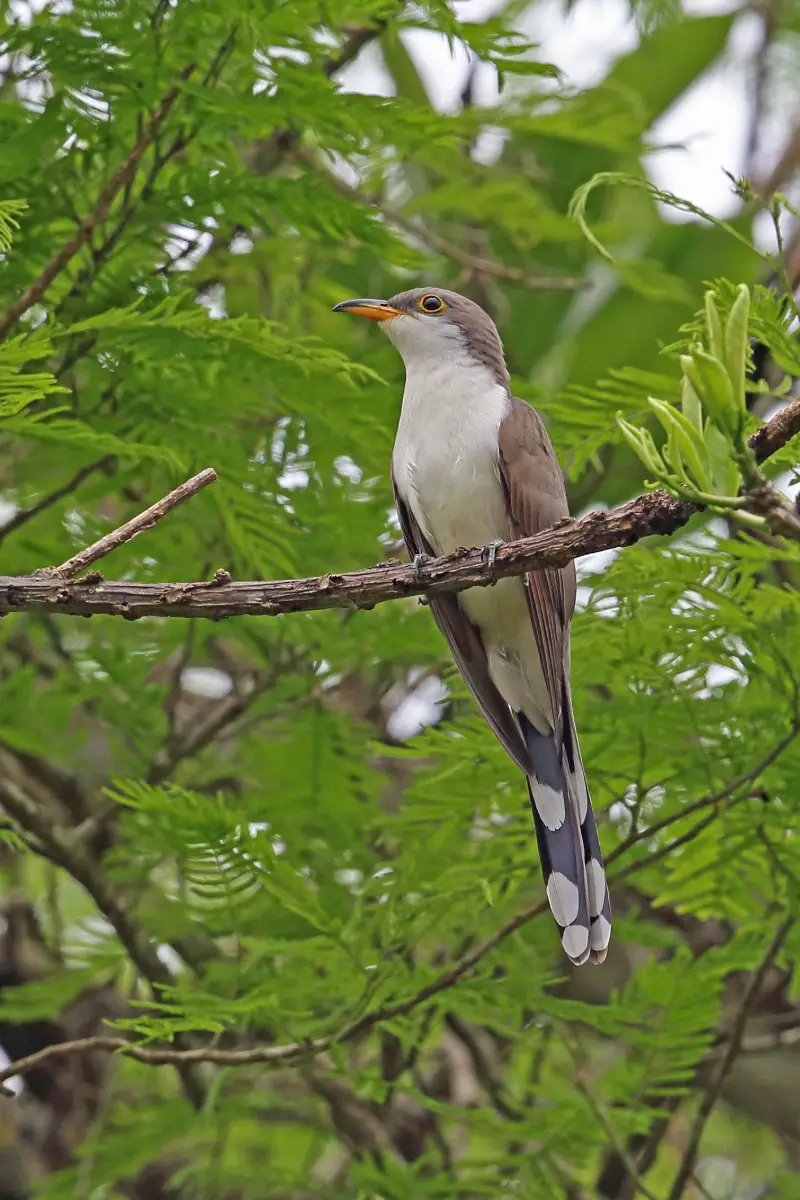
Family: Cuculidae, Cuckoos, Roadrunners, Anis
Description ADULT Has dark gray-brown upperparts, least colorful on crown and darkest through eye. Rufous flight feathers are most obvious in flight. Underparts are otherwise whitish. Tail is long and wedge-shaped when spread; from above, central upper tail is reddish, while rest of tail is black, all feathers having striking white tips; from below, note striking, large white spots (feather tips) to otherwise black tail feathers. Bill is downcurved with yellow base to lower mandible. Note yellow eyering. JUVENILE Similar to adult, but less colorful and with less contrasting undertail pattern.
Dimensions Length: 10 1/2-12 1/2″ (27-32 cm)
Habitat Common summer visitor (mainly May-Sep); winters in South America. Favors dense scrub and woodland, often beside rivers. Usually builds its own nest but occasionally lays eggs in nest of other species, notably Black-billed Cuckoo.
Observation Tips Easiest to see and hear shortly after arrival from migration in late spring.
Range California, Mid-Atlantic, Eastern Canada, Rocky Mountains, Southwest, Texas, New England, Plains, Great Lakes, Florida, Southeast, Northwest
Voice Utters a rapid ke-ke-ke-ke-keeooa-keeooa-keeooa.
Similar Species Mangrove Cuckoo C. minor (L 11-12 in), a Florida specialty, is also widespread in Caribbean. Compared to Yellow-billed, note the dark mask, orange-buff wash on belly and undertail coverts, lack of rufous in wings, and different (a descending series of karr-karr-karrÖ notes). Favors mangroves.
Discussion Unobtrusive, long-tailed woodland bird. Presence often detected by hearing its distinctive call. Feeds on caterpillars, often hairy ones. Sexes are similar.
16. Brown Thrasher
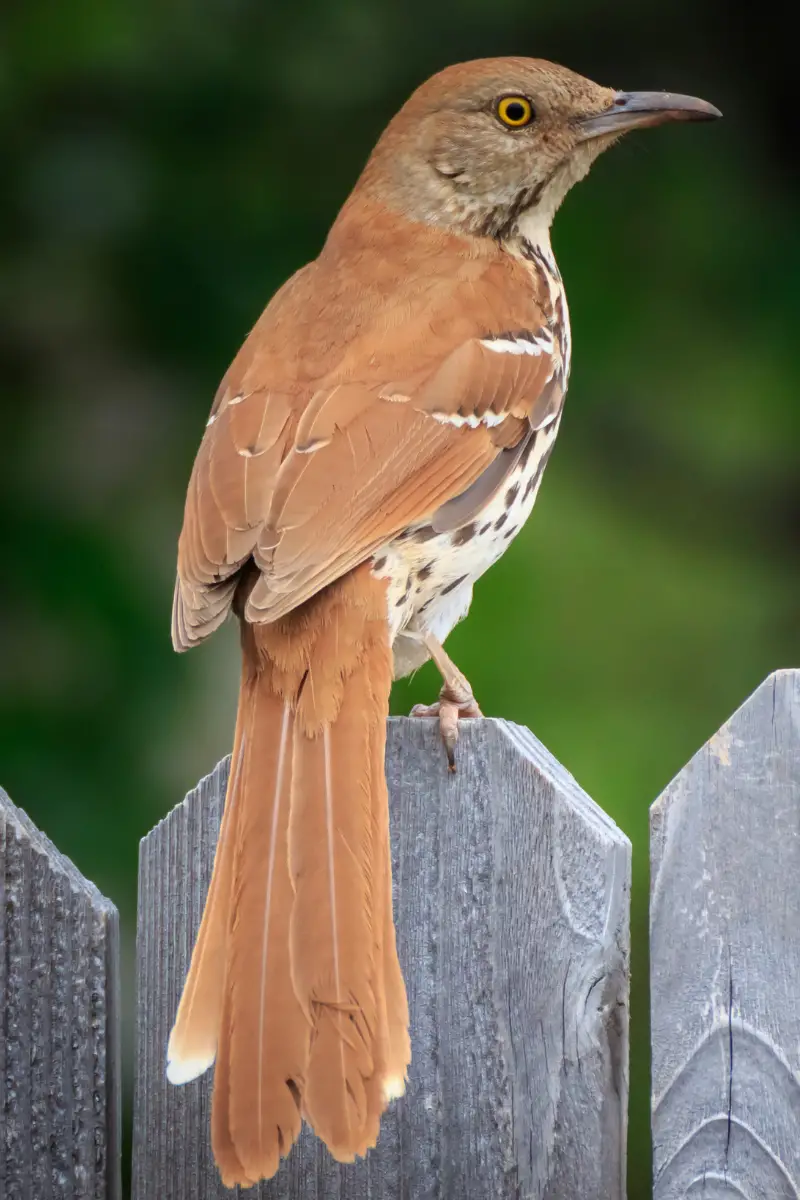
Family: Mimidae, Mockingbirds and Thrashers
Description ADULT Has mainly rich reddish brown upperparts, including tail. Wings have two black and white wing bars, face is grayish, and note the beady yellow eye. Underparts are creamy white, but with bold dark streaks on all parts except undertail. JUVENILE Similar to adult, but with dark eyes.
Dimensions Length: 11 1/2″ (29 cm)
Habitat Fairly common summer visitor (mainly May-Aug) to northern U.S. and Canada; favors dense thickets and scrub. Present year-round in southeastern U.S., where numbers are boosted by migrants from further north.
Observation Tips Easiest to see when singing.
Range Plains, Great Lakes, New England, Eastern Canada, Southeast, Rocky Mountains, Western Canada, Florida, Southwest, Mid-Atlantic, California, Texas
Voice Song is a series of rich, fluty, whistling phrases, each typically repeated a couple of times; calls including a tongue-smacking stutt and a softer chrrr.
Discussion Well-marked, long-tailed, slim-bodied bird with a longish, downcurved bill. Forages mainly on the ground for insects and other invertebrates, but also feeds on berries and seeds. Rather skulking generally, but retiring habits abandoned by territorial singing birds. Sexes are similar.
17. Rock Pigeon
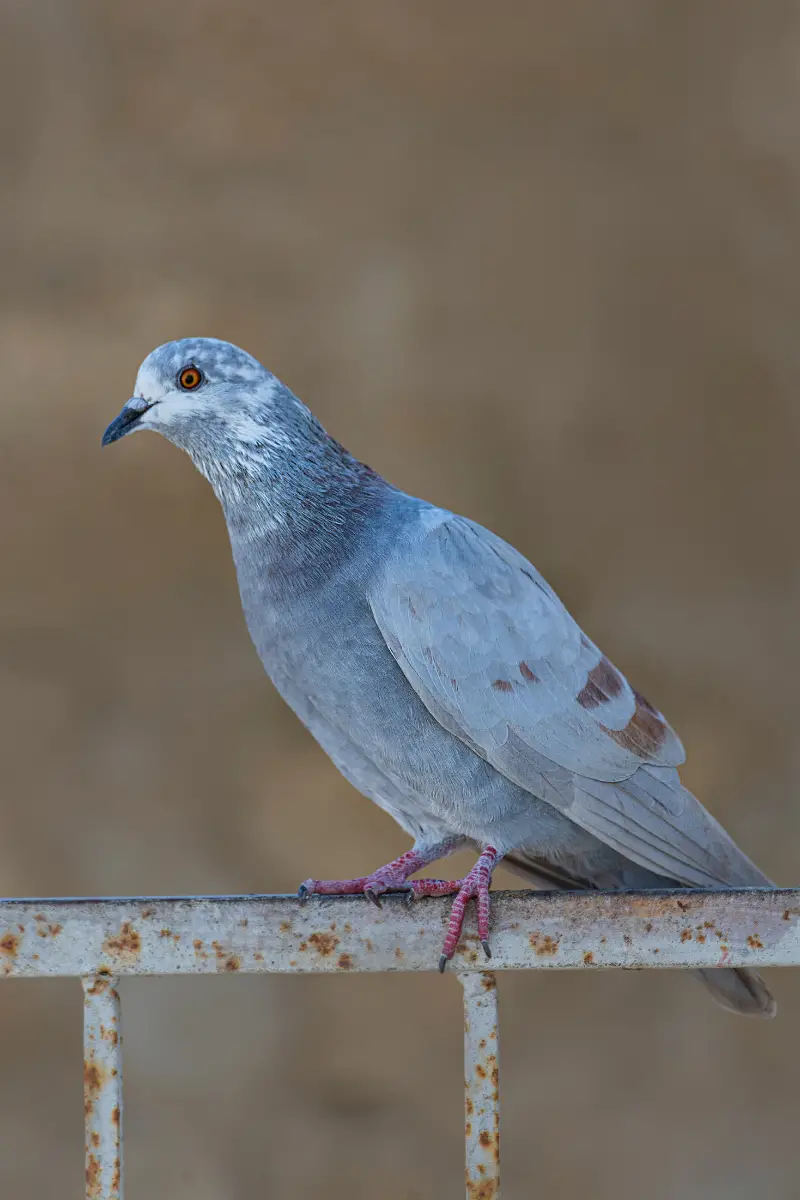
Family: Columbidae, Pigeons and Doves
Description ADULT Ancestral form has blue-gray plumage overall, palest on upper wings and back, and flushed pinkish maroon on breast. Has two dark wing bars and dark-tipped tail. In flight, note small white rump patch; upper wings have dark trailing edge and narrow wing bar, while underwings are white. Pure white, reddish brown and marbled and mottled color forms are all common too. JUVENILE Similar, but duller.
Dimensions Length: 13 1/2″ (34 cm)
Habitat Old World species, introduced by original European settlers and now common and widespread. Favors urban settings where food is available, but also seen on farmland.
Observation Tips Hard to miss. A positive benefit to urban Peregrine Falcons.
Range Southwest, Plains, Western Canada, Florida, Northwest, Great Lakes, Rocky Mountains, California, New England, Texas, Mid-Atlantic, Eastern Canada, Alaska, Southeast
Voice Utters various cooing calls.
Discussion North America’s most familiar pigeon, especially in towns and cities. Typically utterly fearless and many depend to large extent on “hand-outs” from people or carelessly dumped refuse. Forms flocks and usually feeds on ground. Nowadays, most birds are free-living, but centuries of domestication have produced a spectrum of color varieties; hence hard to discern sex differences within species’ overall variation.
18. Brown Creeper
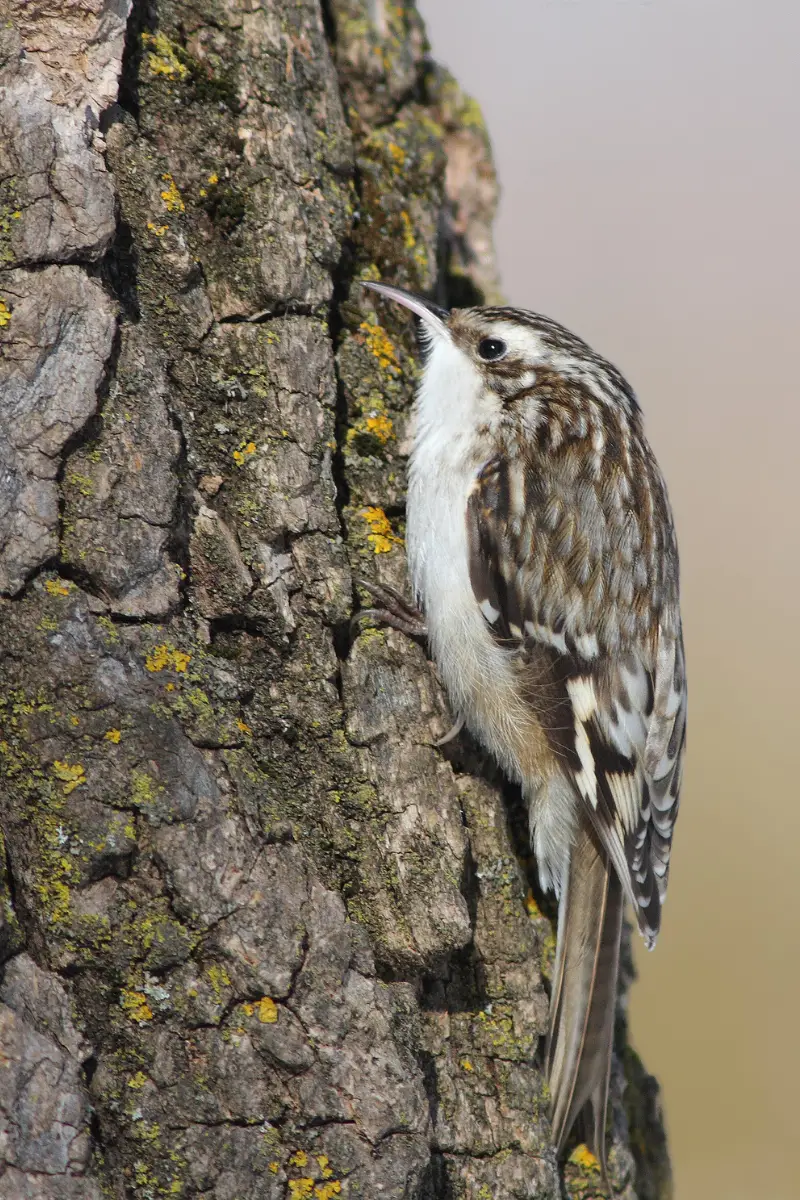
Family: Certhiidae, Creepers
Description ADULT Has brownish upperparts heavily marked with pale teardrop spots on crown, face, and back; note the bold whitish supercilium. Short wings have buffy barring, and rump and base of tail are rufous. Underparts are whitish overall, with buff wash on flanks and undertail. Variation exists in precise hue of upperparts (ranging from grayish to rufous), even within the same regional populations. JUVENILE Similar to adult, but with faint barring on chest.
Dimensions Length: 5-5 3/4″ (13-15 cm)
Habitat Widespread and fairly common in forest habitats; resident in parts of northeast, but northern birds migrate south for winter.
Observation Tips Outside breeding season, search roving mixed-species flocks and listen for its high, thin calls. Note, however, people who are hard of hearing may not be able to detect the notes.
Range Texas, New England, Western Canada, Southwest, Northwest, Alaska, Eastern Canada, Mid-Atlantic, Plains, Southeast, Rocky Mountains, Great Lakes, California, Florida
Voice Song is a series of tsee-see-see notes; call is a thin tsee, recalling that of Golden-crowned Kinglet.
Discussion Unmistakable woodland bird, whose well-marked brown plumage is a good match for tree bark. Feeds by climbing tree trunks in a mouselike manner, probing crevices for small invertebrates with its needlelike, downcurved bill. Spiky tail is used as support and bird typically works its way upwards from base of tree in a spiral manner, then drops to base of adjacent trunk to repeat the process. Sometimes joins roving mixed-species flocks outside the breeding season. Nests in natural crevices under loose tree bark. Several subspecies exist; those from east are described here. Sexes are similar.
19. Painted Bunting
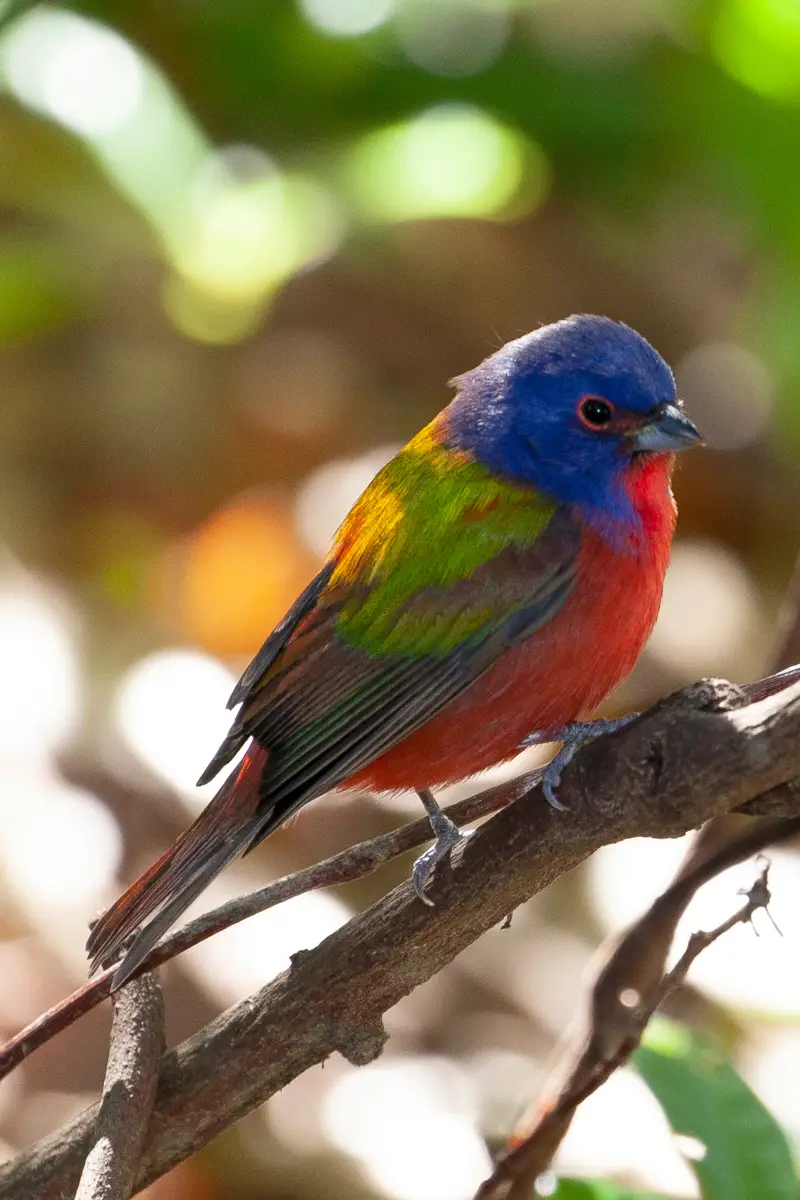
Family: Cardinalidae, Cardinals
Description ADULT MALE Has mostly blue hood, with narrow bright red center to throat; underparts and rump are also bright red. Back is bright yellowish green and wings are brown with green feather margins. ADULT FEMALE Has mostly bright yellowish green upperparts including tail and hood, and mostly paler yellow underparts including narrow throat. JUVENILE Recalls plain, gray-buff version of adult female, with only hint of green on upperparts; by first spring, male has acquired some of adult’s blue and red feathering.
Dimensions Length: 5 1/2″ (14 cm)
Habitat Locally common summer visitor (mainly May-Sep) to dense undergrowth and thickets bordering woods and streams; winters mainly in Central America, but also southern Florida.
Observation Tips Often a challenge to find, despite its bright colors.
Range Plains, Southeast, Florida, Texas, Southwest, California, Mid-Atlantic
Voice Song is a sweet series of warbling whistles; call is a sharp tchip.
Discussion Male is flamboyantly colorful and color combination might be considered vulgar if employed in fashion! Rather secretive nature and unobtrusive habits (often feeds in deep cover) can make it hard to spot. Sexes are dissimilar.
20. Eastern Phoebe
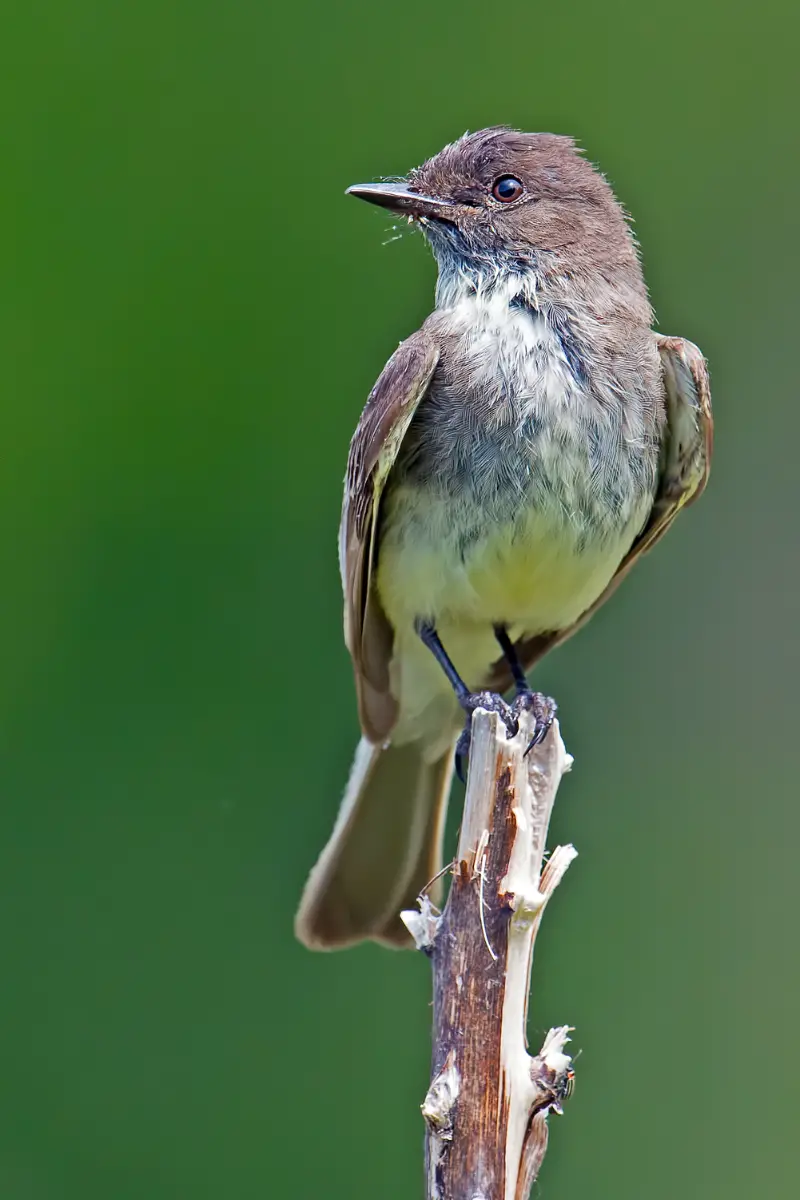
Family: Tyrannidae, Tyrant Flycatchers
Description ADULT Has mainly gray-brown upperparts, darkest on head. Wings are blackish with two whitish wing bars and pale fringes to secondaries and tertials. Throat and rest of underparts are whitish, but with grayish flanks and variably yellow-buff suffusion on belly, most obvious in freshly molted fall plumage. JUVENILE Similar, but with buffy wing bars and subtly more intense yellow wash on belly.
Dimensions Length: 7″ (18 cm)
Habitat Common and widespread summer visitor (mainly Apr-Sep) to woodland, parks, and gardens, across much of eastern North America. Winters in southeastern U.S. and Mexico.
Observation Tips Easy to see, often near water, although frequently unobtrusive; listen for the distinctive song.
Range New England, California, Rocky Mountains, Plains, Alaska, Western Canada, Texas, Great Lakes, Southwest, Eastern Canada, Southeast, Florida, Mid-Atlantic
Voice Utters a sharp chip call; song is a shrill phee-werr, phee-eer-d’dip.
Discussion Squat-bodied flycatcher with understated plumage. Perched bird often pumps forked tail up and down, sometimes with a swaying motion. Flycatches insects, usually from a low perch; sometimes hovers. Often associated with manmade habitats, nesting under bridges or on buildings. Sexes are similar.
21. Common Tern
Family:Laridae, Gulls and Terns
Description ADULT SUMMER Has gray upperparts, black cap, and whitish gray underparts. Compared to Arctic, note black-tipped orange-red bill, longer red legs, and paler underparts. In flight from below, only inner primaries look translucent and wings have diffuse dark tips; from above, outer primaries have dark tips and shafts, inner ones are dark and appear as a “wedge.” ADULT WINTER Similar, but has white forehead and dark carpal bar; bill and legs are dark. JUVENILE Has white underparts, incomplete dark cap, and scaly gray upperparts; leading and trailing edges of inner upper wing are dark.
Dimensions Length: 13-16 in (33-41 cm)
Habitat Locally common. Breeds beside forest lakes in Canada and on Atlantic coast; present mainly May-Sep. Winters on coasts of Central and South America.
Observation Tips Easy to see in summer.
Range Plains, Great Lakes, Alaska, Southwest, New England, Eastern Canada, Western Canada, Florida, Mid-Atlantic, Texas, California, Southeast, Northwest, Rocky Mountains
Voice Utters a harsh kreeear call.
Similar Species Roseate Tern S. dougallii (L 12-13 in) is paler overall with black on wings limited to narrow wedge on upperside of outer primaries. Adult’s bill is mostly black but goes red at base in breeding season. In breeding season has pink flush to underparts and long tail streamers. Rare breeder on Canadian coast and Florida Keys.
Discussion Elegant tern that plunge-dives for fish and hawks insects. Sexes are similar.
Family: Icteridae, Blackbirds and Orioles
Description ADULT BREEDING MALE Has black plumage overall; in good light, has purple sheen on head and blue-green sheen to back, wings, and breast. Note the pale iris. ADULT NONBREEDING MALE Duller, due to brownish feather edges, which gradually wear off. ADULT FEMALE Rather uniform dark gray-brown, darkest on wings and tail. Iris is dark in most birds. IMMATURES Similar to respective sex winter adults.
Dimensions Length: 8-10″ (20-25 cm)
Habitat Commoner west of range covered by this book, but still a widespread summer visitor to farmland and other open habitats. Migrates south in fall and winters in southeastern U.S. Range has expanded overall due to human alteration of natural environment.
Observation Tips Easy to see and often tame in suburban parks and gardens.
Range Mid-Atlantic, Eastern Canada, Southeast, Texas, New England, Northwest, Western Canada, California, Rocky Mountains, Southwest, Florida, Alaska, Plains, Great Lakes
Voice Song is a piercing, squeaky whistle, sometimes followed by call-like tchak notes.
Discussion Widespread and familiar colonially nesting bird. Often bold in suburban locations. Sexes are dissimilar.

